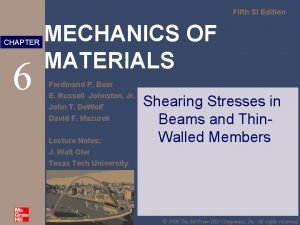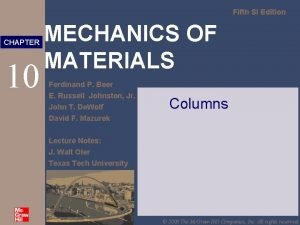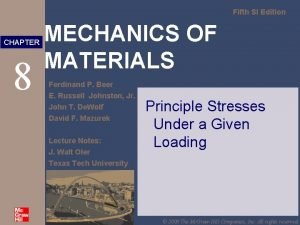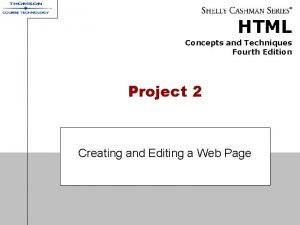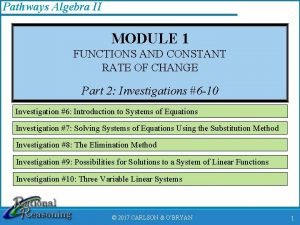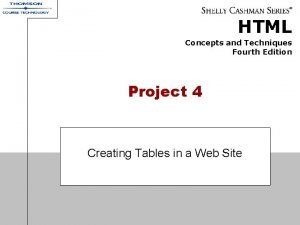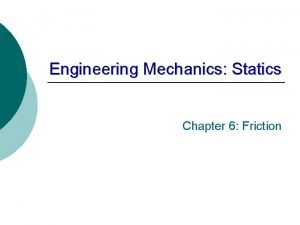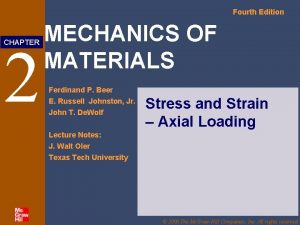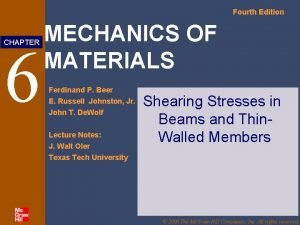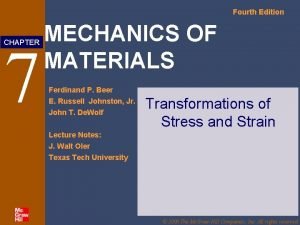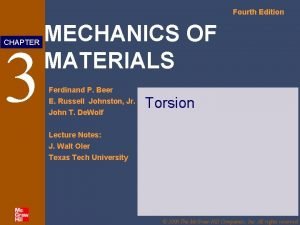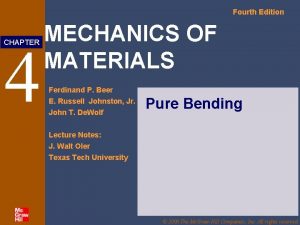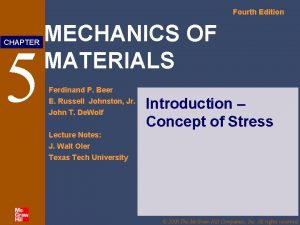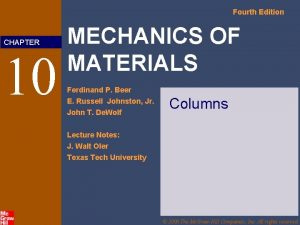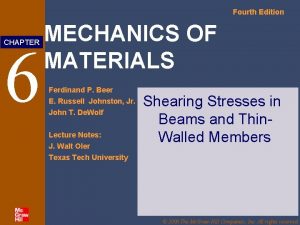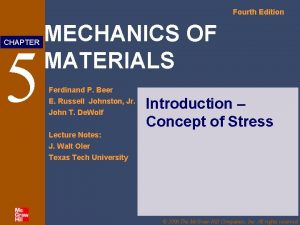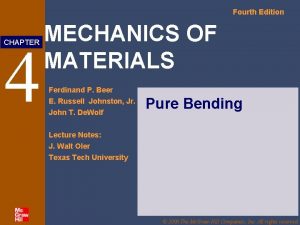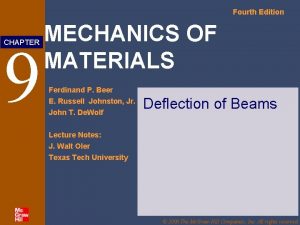Fourth Edition 6 CHAPTER MECHANICS OF MATERIALS Ferdinand















- Slides: 15

Fourth Edition 6 CHAPTER MECHANICS OF MATERIALS Ferdinand P. Beer E. Russell Johnston, Jr. John T. De. Wolf Lecture Notes: J. Walt Oler Texas Tech University Shearing Stresses in Beams and Thin. Walled Members © 2006 The Mc. Graw-Hill Companies, Inc. All rights reserved.

Fourth Edition MECHANICS OF MATERIALS Beer • Johnston • De. Wolf Shearing Stresses in Beams and Thin-Walled Members Introduction Shear on the Horizontal Face of a Beam Element Example 6. 01 Determination of the Shearing Stress in a Beam Shearing Stresses txy in Common Types of Beams Further Discussion of the Distribution of Stresses in a. . . Sample Problem 6. 2 Longitudinal Shear on a Beam Element of Arbitrary Shape Example 6. 04 Shearing Stresses in Thin-Walled Members Plastic Deformations Sample Problem 6. 3 Unsymmetric Loading of Thin-Walled Members Example 6. 05 Example 6. 06 © 2006 The Mc. Graw-Hill Companies, Inc. All rights reserved. 6 -2

Fourth Edition MECHANICS OF MATERIALS Beer • Johnston • De. Wolf Introduction • Transverse loading applied to a beam results in normal and shearing stresses in transverse sections. • Distribution of normal and shearing stresses satisfies • When shearing stresses are exerted on the vertical faces of an element, equal stresses must be exerted on the horizontal faces • Longitudinal shearing stresses must exist in any member subjected to transverse loading. © 2006 The Mc. Graw-Hill Companies, Inc. All rights reserved. 6 -3

Fourth Edition MECHANICS OF MATERIALS Beer • Johnston • De. Wolf Shear on the Horizontal Face of a Beam Element • Consider prismatic beam • For equilibrium of beam element • Note, • Substituting, © 2006 The Mc. Graw-Hill Companies, Inc. All rights reserved. 6 -4

Fourth Edition MECHANICS OF MATERIALS Beer • Johnston • De. Wolf Shear on the Horizontal Face of a Beam Element • Shear flow, • where • Same result found for lower area © 2006 The Mc. Graw-Hill Companies, Inc. All rights reserved. 6 -5

Fourth Edition MECHANICS OF MATERIALS Beer • Johnston • De. Wolf Example 6. 01 SOLUTION: • Determine the horizontal force per unit length or shear flow q on the lower surface of the upper plank. • Calculate the corresponding shear force in each nail. A beam is made of three planks, nailed together. Knowing that the spacing between nails is 25 mm and that the vertical shear in the beam is V = 500 N, determine the shear force in each nail. © 2006 The Mc. Graw-Hill Companies, Inc. All rights reserved. 6 -6

Fourth Edition MECHANICS OF MATERIALS Beer • Johnston • De. Wolf Example 6. 01 SOLUTION: • Determine the horizontal force per unit length or shear flow q on the lower surface of the upper plank. • Calculate the corresponding shear force in each nail for a nail spacing of 25 mm. © 2006 The Mc. Graw-Hill Companies, Inc. All rights reserved. 6 -7

Fourth Edition MECHANICS OF MATERIALS Beer • Johnston • De. Wolf Determination of the Shearing Stress in a Beam • The average shearing stress on the horizontal face of the element is obtained by dividing the shearing force on the element by the area of the face. • On the upper and lower surfaces of the beam, tyx= 0. It follows that txy= 0 on the upper and lower edges of the transverse sections. • If the width of the beam is comparable or large relative to its depth, the shearing stresses at D 1 and D 2 are significantly higher than at D. © 2006 The Mc. Graw-Hill Companies, Inc. All rights reserved. 6 -8

Fourth Edition MECHANICS OF MATERIALS Beer • Johnston • De. Wolf Shearing Stresses txy in Common Types of Beams • For a narrow rectangular beam, • For American Standard (S-beam) and wide-flange (W-beam) beams © 2006 The Mc. Graw-Hill Companies, Inc. All rights reserved. 6 -9

Fourth Edition MECHANICS OF MATERIALS Beer • Johnston • De. Wolf Further Discussion of the Distribution of Stresses in a Narrow Rectangular Beam • Consider a narrow rectangular cantilever beam subjected to load P at its free end: • Shearing stresses are independent of the distance from the point of application of the load. • Normal strains and normal stresses are unaffected by the shearing stresses. • From Saint-Venant’s principle, effects of the load application mode are negligible except in immediate vicinity of load application points. • Stress/strain deviations for distributed loads are negligible for typical beam sections of interest. © 2006 The Mc. Graw-Hill Companies, Inc. All rights reserved. 6 - 10

Fourth Edition MECHANICS OF MATERIALS Beer • Johnston • De. Wolf Sample Problem 6. 2 SOLUTION: • Develop shear and bending moment diagrams. Identify the maximums. • Determine the beam depth based on allowable normal stress. A timber beam is to support the three concentrated loads shown. Knowing that for the grade of timber used, determine the minimum required depth d of the beam. • Determine the beam depth based on allowable shear stress. • Required beam depth is equal to the larger of the two depths found. © 2006 The Mc. Graw-Hill Companies, Inc. All rights reserved. 6 - 11

Fourth Edition MECHANICS OF MATERIALS Beer • Johnston • De. Wolf Sample Problem 6. 2 SOLUTION: Develop shear and bending moment diagrams. Identify the maximums. © 2006 The Mc. Graw-Hill Companies, Inc. All rights reserved. 6 - 12

Fourth Edition MECHANICS OF MATERIALS Beer • Johnston • De. Wolf Sample Problem 6. 2 • Determine the beam depth based on allowable normal stress. Check for shearing stress: © 2006 The Mc. Graw-Hill Companies, Inc. All rights reserved. 6 - 13

Fourth Edition MECHANICS OF MATERIALS Beer • Johnston • De. Wolf • Determine the beam depth based on allowable shear stress. • Required beam depth is equal to the larger of the two. © 2006 The Mc. Graw-Hill Companies, Inc. All rights reserved. 6 - 14

Fourth Edition MECHANICS OF MATERIALS Beer • Johnston • De. Wolf Longitudinal Shear on a Beam Element of Arbitrary Shape • We have examined the distribution of the vertical components txy on a transverse section of a beam. We now wish to consider the horizontal components txz of the stresses. • Consider prismatic beam with an element defined by the curved surface CDD’C’. • Except for the differences in integration areas, this is the same result obtained before which led to © 2006 The Mc. Graw-Hill Companies, Inc. All rights reserved. 6 - 15
 Mechanics of materials chapter 10
Mechanics of materials chapter 10 Mechanics of materials chapter 7
Mechanics of materials chapter 7 Mechanics
Mechanics Beer johnston
Beer johnston Beer and johnson
Beer and johnson Beer mechanics of materials 6th edition chapter 4 solutions
Beer mechanics of materials 6th edition chapter 4 solutions Mechanic of materials
Mechanic of materials Mechanics
Mechanics Project 2 fourth edition
Project 2 fourth edition Pathways algebra 2 answer key
Pathways algebra 2 answer key Ethics in information technology fourth edition
Ethics in information technology fourth edition Ethics in information technology fourth edition
Ethics in information technology fourth edition Vertical line html
Vertical line html A computer programming team has 13 members
A computer programming team has 13 members Expert systems: principles and programming, fourth edition
Expert systems: principles and programming, fourth edition Engineering mechanics (9th) edition chapter 12 problem 30p
Engineering mechanics (9th) edition chapter 12 problem 30p


